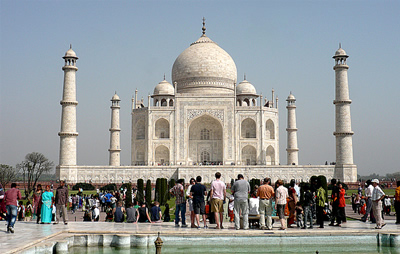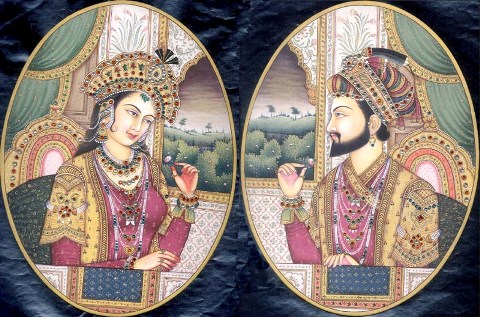World History
There are very few buildings in the world more famous than the Taj Mahal, a queen’s mausoleum in Agra, India. The sense of romance that the Taj Mahal invokes was developed as a result of British fascination with this structure during the late 18th century and has continued into the 21st century.
This monument was built by the Mughal emperor Shah Jahan after his favorite wife, Mumtaz Mahal, died while giving birth in 1631. Shah Jahan was deeply affected by her passing, and her body was carried from Burhanpur to Agra to be entombed until the completion of the Taj Mahal.
In 1631, Shah Jahan began the construction of the Taj Mahal. Despite the fact that a massive labor force was involved in its construction, it took approximately 17 years to complete the main structure. A small village of artisans was created near the site in order to accommodate their immediate needs. In fact, many of the materials used for the construction of the Taj Mahal originated from China, Egypt, and Tibet, and a large number of people were involved, including Europeans.
The layout of the Taj Mahal has symbolic meaning; its main gate symbolizes a barrier between the outside world and the purity and serenity of the inside world. It is constructed of white marble, the color of purity. The use of water in the garden also symbolizes purity, emphasizing the belief that the Taj Mahal is a holy site. As one enters the heart of the mausoleum, Islamic prayers can be read above the doorway, which are recited before a person of the Islamic faith dies.
It has been rumored that Shah Jahan wanted to construct a black marble mausoleum for himself beside his wife’s. But his son and successor, Aurangzeb, did not fulfill his wishes, and he was buried in a separate crypt beside his wife. The architecture and decorating of the Taj Mahal epitomized the highest achievement of the Indo-Islamic artistic style.
- Delhi And Agra
Red Fort in Delhi Delhi, now the capital of India, has been the political center of Indian civilization for over a thousand years. The settlement known as Indraprastha, which was mentioned in the Indian epic the Mahabharata, was located at modern-day...
- Jahangir - Mughal Ruler
Jahangir - Mughal RulerJahangir inherited the Mughal throne from his father, Akbar, the greatest Mughal emperor. His realm included part of Afghanistan and the Indian subcontinent up to the Deccan. It was one of the largest empires of the world and enjoyed...
- Virtual Tours For Your Classroom
One of my favorite exercises when we get to the Renaissance is to show them a virtual tour of the Sistine Chapel as I love looking at the marvel of my students when they see what one person can do. This link will give you access to that tour as well as...
- The Pyramids Deconstructed
Just when I think I have my entire course figured out and ready, along comes a new something or other on the Internet and it's back to figuring out what is best. Above is a short fascinating video deconstructing the pyramids at Giza (which...
- Qwiki
Perhaps I am jumping a bit ahead, but Qwiki is about to go to the alpha phase, meaning if you go to their site, you can sign up to work them on the early stages. Quiki is getting a lot of press and basically will be a search engine that will make...
World History
Taj Mahal
 |
| Taj Mahal |
There are very few buildings in the world more famous than the Taj Mahal, a queen’s mausoleum in Agra, India. The sense of romance that the Taj Mahal invokes was developed as a result of British fascination with this structure during the late 18th century and has continued into the 21st century.
This monument was built by the Mughal emperor Shah Jahan after his favorite wife, Mumtaz Mahal, died while giving birth in 1631. Shah Jahan was deeply affected by her passing, and her body was carried from Burhanpur to Agra to be entombed until the completion of the Taj Mahal.
In 1631, Shah Jahan began the construction of the Taj Mahal. Despite the fact that a massive labor force was involved in its construction, it took approximately 17 years to complete the main structure. A small village of artisans was created near the site in order to accommodate their immediate needs. In fact, many of the materials used for the construction of the Taj Mahal originated from China, Egypt, and Tibet, and a large number of people were involved, including Europeans.
 |
| Shah Jahan and Mumtaz Mahal |
The layout of the Taj Mahal has symbolic meaning; its main gate symbolizes a barrier between the outside world and the purity and serenity of the inside world. It is constructed of white marble, the color of purity. The use of water in the garden also symbolizes purity, emphasizing the belief that the Taj Mahal is a holy site. As one enters the heart of the mausoleum, Islamic prayers can be read above the doorway, which are recited before a person of the Islamic faith dies.
It has been rumored that Shah Jahan wanted to construct a black marble mausoleum for himself beside his wife’s. But his son and successor, Aurangzeb, did not fulfill his wishes, and he was buried in a separate crypt beside his wife. The architecture and decorating of the Taj Mahal epitomized the highest achievement of the Indo-Islamic artistic style.
- Delhi And Agra
Red Fort in Delhi Delhi, now the capital of India, has been the political center of Indian civilization for over a thousand years. The settlement known as Indraprastha, which was mentioned in the Indian epic the Mahabharata, was located at modern-day...
- Jahangir - Mughal Ruler
Jahangir - Mughal RulerJahangir inherited the Mughal throne from his father, Akbar, the greatest Mughal emperor. His realm included part of Afghanistan and the Indian subcontinent up to the Deccan. It was one of the largest empires of the world and enjoyed...
- Virtual Tours For Your Classroom
One of my favorite exercises when we get to the Renaissance is to show them a virtual tour of the Sistine Chapel as I love looking at the marvel of my students when they see what one person can do. This link will give you access to that tour as well as...
- The Pyramids Deconstructed
Just when I think I have my entire course figured out and ready, along comes a new something or other on the Internet and it's back to figuring out what is best. Above is a short fascinating video deconstructing the pyramids at Giza (which...
- Qwiki
Perhaps I am jumping a bit ahead, but Qwiki is about to go to the alpha phase, meaning if you go to their site, you can sign up to work them on the early stages. Quiki is getting a lot of press and basically will be a search engine that will make...
